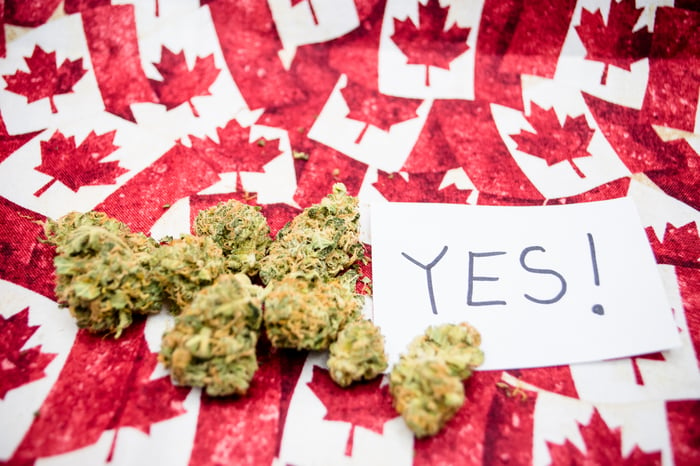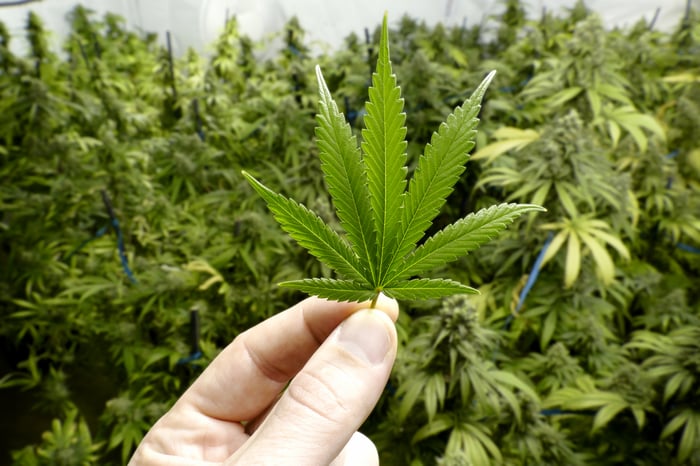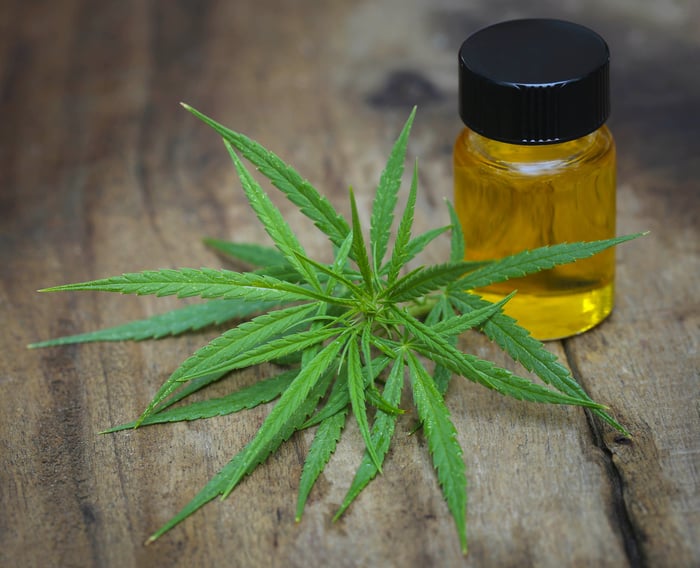Spring is in the air, but flowers aren't the only thing blooming. The legal marijuana industry is turning the heads of Wall Street, investors, and pot enthusiasts with a superior growth rate and a discernible shift in opinion among the public.
In North America, legal weed sales are forecast to grow by 28% per year through 2021, according to ArcView Market Research, which could put total sales at almost $25 billion by 2021. Further, a decade from now, ArcView sees North American sales surging to more than $47 billion.

Image source: Getty Images.
In terms of favorability, the latest Gallup poll in October 2017 found that a record 64% of respondents supported the idea of legalizing cannabis nationally. That's up from just 25% in 1995, the year before California became the first state to OK the use of medical marijuana for compassionate-use patients. A separate poll from the independent Quinnipiac University in August found even stronger support for legalizing medical weed. Some 94% of survey-takers were in favor of the idea, compared to just 4% opposed.
Canada's green rush is on
But the real excitement can likely be attributed to the expected legalization of recreational marijuana in Canada by this coming summer. There isn't a developed country in the world that's legalized adult-use weed, and for that matter, only one other country (Uruguay) has OK'd the sale of cannabis to adults. An approval of the Cannabis Act, which seems very likely at this point, should add at least $5 billion in annual sales to an already thriving industry.
With expansion seemingly on the horizon, Canadian marijuana growers have been using every ounce of operating cash flow and capital to expand their production capacity. Though estimates vary, Canada could demand around 800,000 kilograms of cannabis a year, and when the proverbial green flag drops later this year, growers want to be able to secure as much market share as possible.
There are, in particular, two key reasons growers would want to stockpile production ahead of the expected August or September start date for legal recreational sales. First, having a lot of product in retail stores may allow producers to forge an attachment with consumers. Though the packaging and labeling requirements introduced by Health Canada will de-emphasize logos and branding, the launch of recreational weed is still an opportunity for cannabis producers to hook consumers on a particular brand and develop rapport.

Image source: Getty Images.
Secondly, and arguably most importantly, being among the top producers out of the gate -- not necessarily two or three years from now -- could open the door for long-term supply agreements with individual provinces, retailers, and even other growers looking to expand their product lines. These supply agreements offer cash flow and sales stability to an otherwise volatile industry.
This past week, Canada's largest supply agreement to date was handed out, and chances are, you've probably never heard of the company.
This unknown pot stock just landed Canada's largest recreational weed supply deal
The Canadian cannabis market currently has a trio of growers that stand head and shoulders above the rest.
- Canopy Growth Corp. (CGC -2.01%): Canopy is currently building or developing greenhouse facilities on 3.7 million square feet of land in British Columbia. Though tight-lipped on annual production, 300,000 kilograms or more annually probably isn't out the question.
- Aurora Cannabis (ACB -3.82%): A company growing aggressively by acquisition, Aurora Cannabis is expected to produce 283,000 kilograms in annual, fully funded cannabis. The Aurora Sky project may very well be the most technologically advanced greenhouse when complete by mid-2018.
- Aphria (NASDAQOTH: APHQF): Aphria estimates that it'll yield about 230,000 kilograms a year once fully ramped up, including 100,000 kilograms from its organic, four-phase expansion, and 120,000 kilograms from its partnership with Double Diamond Farms.

Image source: Getty Images.
Yet, all three of these major players share something else in common: Their long-term supply agreements with Canada's provinces are peanuts compared to what Hydropothecary Corporation (HEXO) just secured with Quebec. Now, keep in mind that this aforementioned trio is expected to play a role in Quebec, with Canopy Growth and Aphria both supplying up to 12,000 kilograms a year for three years, and Aurora Cannabis announcing a minimum of 5,000 kilograms a year for the first year, with no set maximum. But it was Hydropothecary's five-year deal for a total of 200,000 kilograms with Quebec that takes the cake.
The announced agreement with Quebec's regulatory authority will see the company offer 20,000 kilograms in supply in year one, 35,000 kilograms in year two, 45,000 kilograms in the third year, 50,000 kilograms in year four, and 55,000 kilograms in the final year, with the option for Quebec to extend the agreement to a sixth year. It should be noted that supply in the fourth and fifth years hasn't been finalized, albeit Hydropothecary is estimating 10% annual demand growth. Following the deal announcement, Sebastien St. Louis, CEO of Hydropothecary, said, "This is over [CA]$1 billion in forward revenue over five years."
What Hydropothecary brings to the table
The company plans to meet Quebec's demand, and that of the general consumer in Canada, by expanding its Quebec-based operations. In December 2017, the company announced the acquisition of 78 acres adjacent to its existing 65-acre Gatineau, Quebec facility. A newly constructed 1 million square-foot greenhouse is expected to boost capacity to 1.3 million square feet and increase fully funded annual capacity to 108,000 kilograms. And, according to St. Louis, this expansion is over a month ahead of schedule, suggesting that it'll be completed by this coming December.

Image source: Getty Images.
Hydropothecary also offers products beyond traditional dried cannabis, which adds to its appeal. The company has been expanding its line of extracts, oils, and marijuana powder (known exclusively as Decarb), and it has been focusing on higher-priced cannabis strains for niche consumers. All of these products carry a higher price point than traditional dried cannabis, which in this case means a higher-margin product. And, since these products are focused on a more affluent consumer, they're probably less likely to be affected by economic fluctuations, leading to more consistent sales for Hydropothecary.
Then again, investors should also understand that Hydropothecary faces many of the same risks as its peers. There remains the concern that oversupply in Canada could wreck margins. Even with long-term supply agreements in place, profits could come in well below where Wall Street is forecasting if a supply glut hits Canada and growers are unable to offset it by exporting cannabis to medically legal foreign markets.
Hydropothecary has also been turning to bought-deal offerings to raise capital, just like its peers. While it's found plenty of investors, these bought-deal offerings have a tendency to balloon outstanding share counts either up front, or within a few quarters. A rising outstanding share count dilutes the value of existing shares and can adversely impact earnings per share, making a company's valuation appear frothier.
As with practically all pot stocks at the moment, Hydropothecary is best viewed from the safety of the sidelines. But with a major supply agreement now in place, it's time to recognize that it's becoming a major player.





